 Essential Herbs For Beauty, Health, and Delicious Eating
Essential Herbs For Beauty, Health, and Delicious Eating
It’s wonderful to have a year round herbal “pharmacy” for beauty, comfort, and health right at your fingertips. Planting from early Spring to Early Summer is the time to do for outside herbs. If you don’t consider yourself to have a green thumb, then consider that all of these can be grown in a flowerbox or in pots on the patio or balcony, with a minimum of effort, anytime of the year. Good sun exposure, a little water, and you can begin harvesting the young leaves in a couple of months. I recommend making teas and infusions by soaking the leaves or flowers in a pot of hot water for a good 10 minutes, then straining into a cup to drink, or apply topically, right away. Most of the teas can be stored for up to 5 days in a tightly closed glass container in the fridge. Cut them fresh for adding to food recipes, and dry them for long term storage and use. You’ll never go back to store bought herbs again!
Holy basil (tulsi) Place the mature shrub near a doorway or window to get the full effect of its rich, spicy scent. Make an infusion of the leaves for a tea to drink, which produces high antioxidant protection against free radicals and helps bolster the immune system, purify the blood and balance the digestive system. Drinking the tea will also provide a calming effect and relief from feelings of stress and anxiety. Chewing the leaves will support healthy gums and prevent mouth ulcers. Gargle the tea for sore throat relief and to break up mucus from post nasal drip.
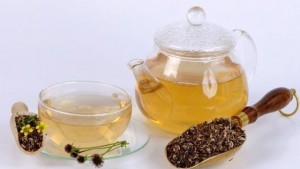
Lemon Verbena Leaves steeped and used as tea, are extremely relaxing, lower blood pressure, slow heart rate, ease cramps and indigestion, and strengthen the nervous system. It is the premier garden herb for tea drinking due to its superior and unique flavor. Mixed with lavender, the dried flowers and leaves make the most beautiful potpourri imaginable. An easy way to use the leaves in food, is to steep them in any kind of unflavored/plain milk (soy, almond, hemp, organic cow) that can then be used as an ingredient for puddings, cake or cookie icings, or homemade ice cream — for anything calling for milk that would be pleasant with a lemony addition. The tenderest leaves can be used chopped up in salad dressings or in fruit salads, or left whole as a garnish for chilled drinks.
Mint (spearmint, pineapple mint, chocolate mint, peppermint) Hot mint tea is good for colds, fever, indigestion and stomach upset. Chilled tea made from dried leaves makes a great foot soak, and face spray for a hot day. Fresh mint leaves can be mixed with fruit salad for a tasty twist. Add spearmint leaves to just about any kind of grain/legume salad (tabouli, couscous or lentil); blend with cucumbers and yogurt for a classic raita dip.
Thyme is a member of the mint family, with over 100 varieties. Honey from bees that feed on thyme flower nectar is a gourmet delight. Yet interestingly enough, insects are repelled by thyme. Make a cup of thyme tea, put it in a plant mister, and spray around doorways and windows in summer to repel insects. Thyme strengthens the immune system, so when feeling a cold coming on, make a tea from the dried or fresh leaves. It is also useful for easing menstrual cramps and headaches. The fresh or dried leaves as well as flower tops work well to flavor soups, stews, baked or sauteed vegetables, and is especially tasty when paired with olives.
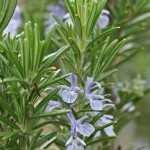
Rosemary “Where rosemary grows, the goddess goes”. The aroma from the growing plant increases brain alertness and counteracts depression and sadness. Its volatile oils are antimicrobial/antiseptic: put fresh sprigs in bath or foot soak for detoxification and to reduce swelling; make tea out of dried leaves for mouthwash to kill bad breath.
Boil a handful of rosemary in 2 cups of water for 10 minutes to yield an antiseptic solution for washing bathroom fixtures. Lay sprigs among linens. Scatter the stems on a barbecue to discourage insects. Add minced rosemary to breads and muffin dough; sprinkle on roasted potatoes or mix with butter for a tasty spread for roasted or steamed vegetables.
Lavender Lavender is a member of the mint family and is useful for easing stress and calming agitation; it is antimicrobial & antiseptic. Make a tea infusion and dab on insect bites and burns, make a sachet of dried flowers to drop into bath or to tie up in a mesh bag for a lingerie drawer sachet. Put the fresh or dried leaves into a mesh bag and place under your pillow for a calming and restful night’s sleep. The weight of your head as it shifts during sleep will release the lavender’s aroma. Mix the fresh flowers into honey and butter for lovely spreads to put on toast and scones. Mix into vanilla ice cream and cake batters.
Sage takes its name from the Latin salvare (to cure); there is no part of this plant that cannot be used. The leaves, flowers and stems all have healing attributes. Use fresh sage for the most efficacy, and make into an infusion. Dab on insect bites, gargle for sore throats and mucus build up, drink as a tea for respiratory congestion. Because sage has a powerful antiseptic effect, combine a tablespoon of strong sage tea with your toothpaste to help remove plaque and tone the gums. As a mainstay savory herb, add fresh or dried sage to bean and potato dishes, as well as gratins, casseroles and pastas.
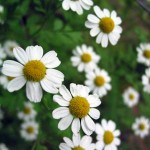
German Chamomile This member of the sunflower family has powerful flavonoides which effect the nervous system. Make a tea out of fresh or dried flowers for upset stomach, stress or insomnia. Chamomile also has an effect on the immune system and helps fight off colds and infections. Cold chamomile tea is a great eyewash for tired and red eyes. A chamomile flower bath is great for relieving skin irritations. Wash your face with unsweetened chamomile tea to treat acne or bee stings. Brunettes or dark shades of blondes may consider taking the unsweetened tea to rinse their hair after it has been washed. It is a great and natural way to bring out the gold highlights.
Calendula (Pot Marigold) Calendula has been used both for cooking and for medicine since the sixteenth century. The flowers of calendula were once used to give cheese its yellow color. You can use both the leaves and flowers of the herb calendula. But make certain you have planted calendula and not another plant that is called marigold (of which there are many). Calendula is THE treatment for skin. It promotes skin cell division and hence healing. It is anti-inflammatory and can be used for cuts, scrapes, rashes, heat burns, sunburn, insect stings and acne. Make a strong tea by cutting up the flowers and leaves and steeping in hot water, then spray or dab onto the affected area. Put the flowers into a mesh bag and then toss into a warm bath for an overall body treatment. Its bright orange and yellow flowers look pretty wherever it grows; its flavor is slightly sweet at first then turns tart. It’s good to add to salads, like nasturtium flowers.
Basil, oregano, lemon balm, garlic, fennel are also easily grown and extremely beneficial herbs to have around for multiple uses.
Growing Your Herbs:
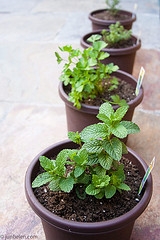
Always try to source organic seeds from specialty seed purveyors (found in abundance on line; check the resource section on page ? for my list). If purchasing non-organic seeds, seedlings or mature plants from a nursery or plant store, make sure you have the Latin name with you to check on the seed packet or plant label. The varieties of herbs found in ordinary garden centers are often modified garden cultivars, and often incorrectly labeled, grown as a GMO crop, and with heavy pesticides.
The time to plant herbs outside depends on your zone and when your last freeze is over. For most places in the US this is late April. Herbs germinate in about a month from the day of planting. Herbs can grow, literally, anywhere in a garden: in between other vegetables, in border beds, along walkways – they are naturally used to surviving in crowded or difficult conditions. The more sun exposure, the better (few will grow in deep shade); at least 6 hours a day is optimal.
Make sure your soil is well turned over with a spade and supplemented with a good organic compost or mulch (you can buy this in small bags from the garden center). Generally, the seed packets have all the details about how to plant your seeds. Push the seeds gently down into the soil as deeply as the seed is long. Tap the soil on top a few times and water just enough to see it soak easily into the soil. (Don’t let the water pool in the dirt). Keep the soil moist (watering every other day should do it unless you live in a super dry or windy climate). Keep pests away by spraying an infusion of thyme, lavender or sage (all natural insect repellents) on the plants where you spot any pests.
If you are planting in pots or window boxes, get a bag of organic potting soil at your garden center and fill the pot to about an inch from the lip with it. Make sure each container has a drain hole and make sure it does not get clogged up, or your plants will develop root rot. Water when you can stick your index finger down in the soil to the first knuckle and feel no moisture. Boost the soil with compost or an organic fertilizer like fish emulsion.
Cut your herbs with kitchen scissors when you are ready to start harvesting them. Make sure they are mature enough to lose some leaves and flowers before you start taking them.
They will grow thicker and fuller when they are regularly pruned, but will struggle if you cut them away before they can handle it.
Once you start growing annual herbs, collect the seeds or let the plants go to seed naturally in the ground. Some herbs need dividing or thinning out every few years, but most will live happily undisturbed in the same place without a lot of attention once they are thriving.
Drying and Storage:
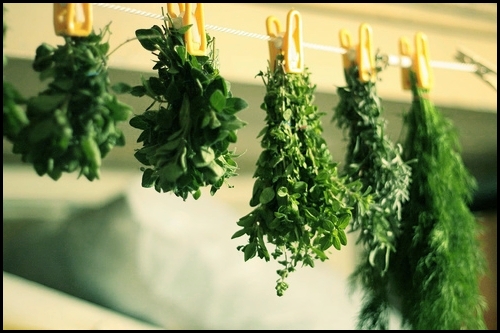
The classic picture in most people’s minds of dried herbs has them hanging in bunches from broad wooden beams in a gloriously rustic kitchen. Truthfully, hanging herbs to dry takes a long time and often, not enough dry air circulates around them, which creates an opportunity for fungi to grow on the leaves. Any kind of overtly humid climate/household will add to the challenge.
Herbs need to be dried quickly, in reasonably high temperatures and away from sunlight. A basic kitchen oven is the genius tool at hand. Line a cookie sheet with parchment baking paper. (Do not use wax paper as the wax will melt and smoke and ruin the process). Spread out the herbs in a thin layer on the paper. Set the oven temperature to 110 f. Electric ovens are better than gas, if possible. Keep the oven door open a bit if your lowest temperature is doesn’t go down to 110. Don’t use a fan (convection) oven. Delicate leafy herbs will only take about an hour to dry, while sturdier ones a little longer. Check periodically and when they are easily crushed in your fingers, they are ready.
To retain the flavor and fragrance of dried herbs, store them in dark glass or pottery containers with tight fitting lids so the oils will not escape. Try to fill the jar all the way to the top so there is very little air remaining. If the jar is clear glass, then store in a dark cabinet away from light.
Never store in a plastic container, as the plastics will leach into the herbs. Most herbs will have a shelf life of two years, when dried, but check them from time to time by smelling and observing their color to make sure they haven’t gone bad.

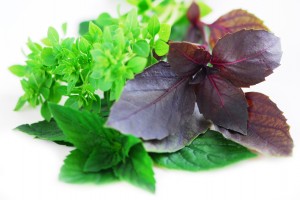 Essential Herbs For Beauty, Health, and Delicious Eating
Essential Herbs For Beauty, Health, and Delicious Eating
Recent Comments